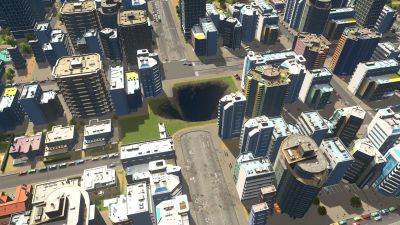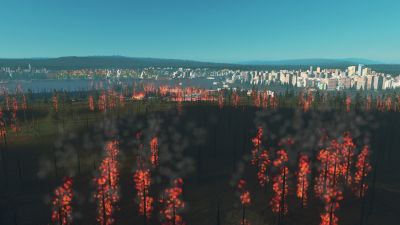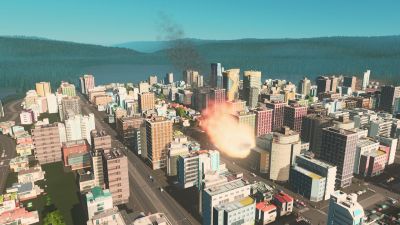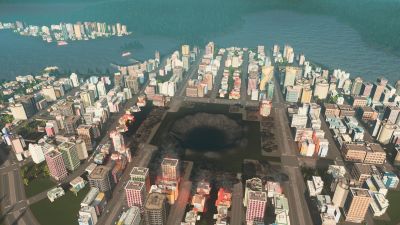“Disasters”的版本间差异
阅读
2023-11-30更新
最新编辑:Lu_23333
阅读:
更新日期:2023-11-30
最新编辑:Lu_23333
(翻译) |
(翻译) |
||
| 第5行: | 第5行: | ||
== 龙卷风 == | == 龙卷风 == | ||
龙卷风是由旋转的尘土和瓦砾组成的圆柱,伴随着风雨,还有闪电。它沿途会击倒树木,摧毁建筑,所过之处留下被淹没的痕迹。 | |||
[[灾难救援服务|气象雷达]]用于预测强雷暴和龙卷风。它提供早期预警和大致的位置。一座气象雷达足以覆盖整个城市。它的提前预警时间取决于“应急服务”的[[经济|预算]]。 | |||
<gallery widths=400px heights=225px> | <gallery widths=400px heights=225px> | ||
File:disaster_tornado.jpg| | File:disaster_tornado.jpg|灾难:龙卷风 | ||
</gallery> | </gallery> | ||
| 第111行: | 第111行: | ||
== 火灾不会蔓延 == | == 火灾不会蔓延 == | ||
{{#lst: | {{#lst:Fire_Department|Disabling fire spreading }} | ||
== 另请参阅 == | == 另请参阅 == | ||
| 第117行: | 第117行: | ||
* See [[Disaster Services]] for the buildings and vehicles that respond to disasters and give early warnings. | * See [[Disaster Services]] for the buildings and vehicles that respond to disasters and give early warnings. | ||
* See [[Landscaping_and_Disasters#Disasters|Landscaping and Disasters]] for in-game disaster controls. | * See [[Landscaping_and_Disasters#Disasters|Landscaping and Disasters]] for in-game disaster controls. | ||
== 参考来源 == | |||
<references /> | |||
2022年7月18日 (一) 19:18的版本
请帮助检查更新本页。最后检查:版本1.14
![]() 必须启用《大灾难》DLC
必须启用《大灾难》DLC
灾难 是《大灾难》DLC 新增的功能。这些灾难有几种生成方式,可以是由剧本中的触发条件生成,也可以随机生成,或者由玩家手动生成。
龙卷风
龙卷风是由旋转的尘土和瓦砾组成的圆柱,伴随着风雨,还有闪电。它沿途会击倒树木,摧毁建筑,所过之处留下被淹没的痕迹。
气象雷达用于预测强雷暴和龙卷风。它提供早期预警和大致的位置。一座气象雷达足以覆盖整个城市。它的提前预警时间取决于“应急服务”的预算。
地震
Earthquakes shake the ground and terrain levels change. They often destroy roads and buildings leading to an extensive rebuild. Underground infrastructure such as water pipes, metro/train/road tunnels can also be destroyed. Earthquakes may cause structure fires. In higher intensity quakes, buildings may collapse even away from the epicenter and ground deformations.
The player can build "Earthquake Sensors" to provide early warning of earthquakes and sinkholes. These buildings have a range, which is dependent on the "Emergency Services" budget, therefore multiple sensors may be required to cover a large city.
地陷
A sinkhole creates a hollow in the ground which can cause collapse of buildings and roads. Underground infrastructure such as water pipes, metro/train/road tunnels can also be destroyed.
The player can build "Earthquake Sensors" to provide early warning of earthquakes and sinkholes. These buildings have a range, which is dependent on the "Emergency Services" budget, therefore multiple sensors may be required to cover a large city.
雷暴雨
Thunderstorms bring wind and rain along with lightning strikes which can do damage to the electrical grid by destroying power lines and towers. Lightning strikes may start forest fires or structure fires.
The Weather Radar predicts strong thunderstorms and tornadoes. It provides early warning and approximate location. One Weather Radar building is sufficient to cover the entire city. Its forecast advanced warning time depends on the "Emergency Services" budget.
![]() Use of the Lightning Rods policy lowers the likelihood of buildings catching fire during a thunderstorm.
Use of the Lightning Rods policy lowers the likelihood of buildings catching fire during a thunderstorm.
森林大火
Forest fires are a conflagration in the trees which expands outwards from the source and can burn down buildings. The city can be protected by removing nearby trees with the bulldozer tool. Burning trees cannot be bulldozed. An announcement about a forest fire will not occur until Cims can see the fire, by which point it is dangerously close to city structures.
The use of "Firewatch Towers" can provide early warnings of approaching fires. A "Fire Helicopter Depot" is required to dispatch firefighting helicopters to extinguish the flames. Each depot supports three helicopters which have to dip their buckets into a water source (river/lake/sea) to fill them before traveling to the location of the fire.
Trees "grow back" after being burned.
Spreading fire can be disabled by the player.
倒塌
A building in the city falls down and people may be trapped inside.
失火
A fire that spreads from building to building.
Spreading fire can be disabled by the player.
海啸
A tsunami is a wall of water that floods the local area, which may wash vehicles off the roads. Some buildings may collapse due to the large volume of water striking them, and Underground Metro Stations are particularly vulnerable. The water may travel a significant distance inland depending on the geography and size of tsunami.
If the flooding persists, buildings will become abandoned. Flood water may cause many other problems in the city, such as blocked roads/rails delaying or stopping the transportation of goods and citizens. Services such as healthcare, death care, police, fire, and garbage collection can all be reduced by blocked roads, flooded or collapsed service buildings. Water, sewer and power can be disrupted as well due to flooding.
Polluted water that is washed into the city will leave pollution behind for awhile. Any polluted pools of water in low lying areas will remain polluted.
The "Tsunami Warning Buoy" monitors the water level for changes indicating a tsunami is approaching. The sensitivity is dependent on the "Emergency Services" budget, and it decreases below 100% funding, but does not increase above 100% funding. Buoys must be placed in the water within the city limits, which affects the warning time given. A keen eye may spot an incoming tsunami well outside the city limits long before the buoy is able to detect it.
Building away from bodies of water, especially on higher ground can reduce or eliminate the threat posed by Tsunamis. Also, using the Landscaping Tools, the player can build dykes/levees/ditches that may prevent the water from entering the city. Strategically placed flood walls, decorative cliffs, and canals may also help to keep water out of the city, however larger tsunamis may go right over them.
The "Pumping Service" can send out trucks to vacuum up the water and return to the "Pumping Service" building to dispose of the water, which leaves the building via the sewer service. Ensure the sewer service is not disabled by the tsunami.
陨石撞击
The meteor strike is a ball of flaming rock from the sky that devastates a large area and touches off several fires. Underground infrastructure such as water pipes, metro/train/road tunnels can also be destroyed.
The "Deep Space Radar" increases the warning time the city receives when an approaching meteor is detected, and it can also show the approximate impact area. This allows for improved evacuations to shelters if they are available. One radar building is sufficient to cover the entire city. The warning time is dependent on the "Emergency Services" budget. It does not increase above 100% funding, but does decrease with lower than 100% funding.
连锁灾难
It is possible for one disaster to lead to another and the gallery below shows a meteor striking water and causing a tsunami.
玩家生成的灾难
The player may create a disaster of their choosing to occur in the city. These are selected from the "Disasters" tab within the "Landscaping and Disasters" menu. A slider will appear to allow the player to adjust the intensity of the disaster if applicable. ("Collapse" does not have varying intensities.) A crosshair will appear to allow the player to place the disaster in the desired location. Note that some disasters cover large areas, and tsunamis have no location, so the location is not particularly important in that case. Each disaster has a cool down period before another of the same disaster can be placed. The delay time for the cool down differs between the disasters.
火灾不会蔓延
火灾不会蔓延 是一项设置选项,可在 选项 - 控制设定 中找到。
该选项适用于,从森林大火到建筑失火,所有类型的火灾。此选项开启时,火焰不会从一棵树蔓延到另一棵树,从而防止大规模的森林火灾。它还阻断了火灾从树木蔓延到建筑,从建筑蔓延到建筑,等等。注意,如果启用了随机灾难,此选项会被禁用。另外,游玩某个剧本时,也会关闭此选项。
火灾行为的更新也带来了火灾对放置在路径上的《公园生活》DLC 和《校园》DLC 的建筑放置的道路/小径所改变。通常情况下,这些建筑只有在放置在路边时才会着火。然而,如果玩家安装了 "自然灾害",并解锁了直升机,开启了随机灾害,或者正在玩一个剧本,那么放置在小径旁边的建筑物也会着火。[1]
另请参阅
- See Natural Disasters for the DLC information page.
- See Disaster Services for the buildings and vehicles that respond to disasters and give early warnings.
- See Landscaping and Disasters for in-game disaster controls.
参考来源
- ↑ Paradox论坛:《校园》开发日志 #6:免费更新 火灾行为更新 - CO Emmi(Colossal Order),2019-05-17





















 沪公网安备 31011002002714 号
沪公网安备 31011002002714 号